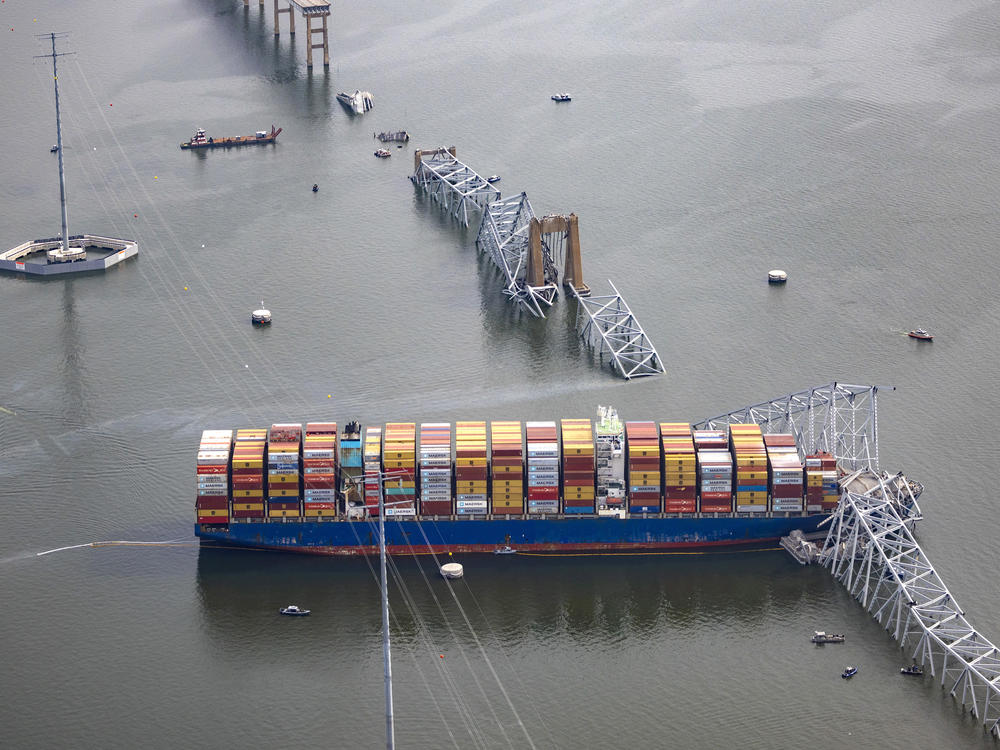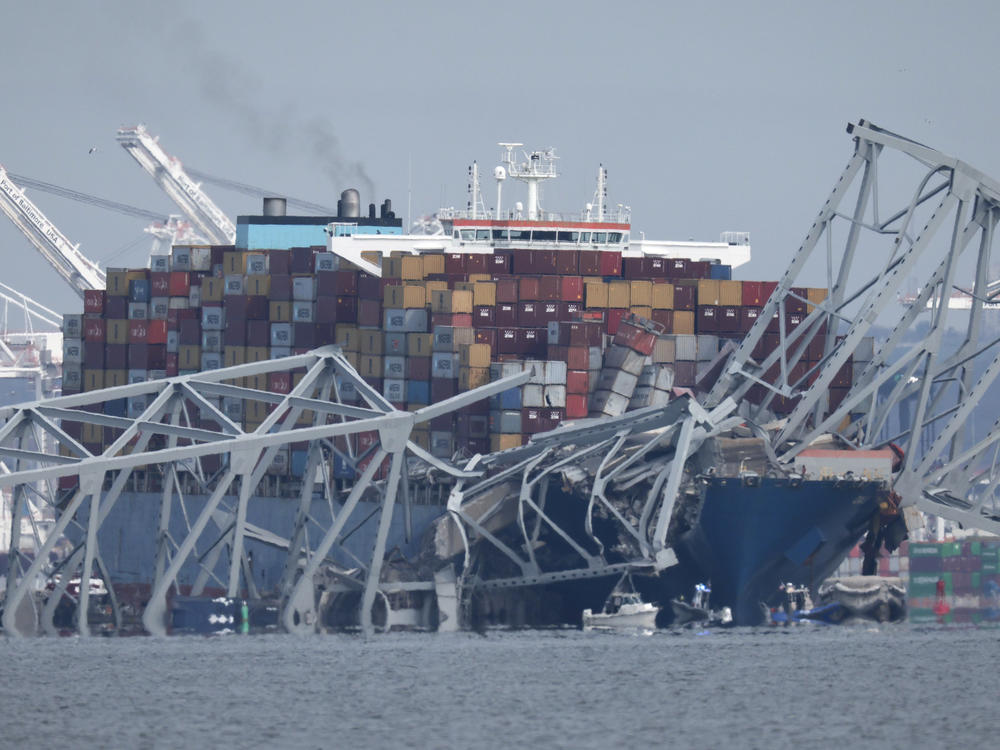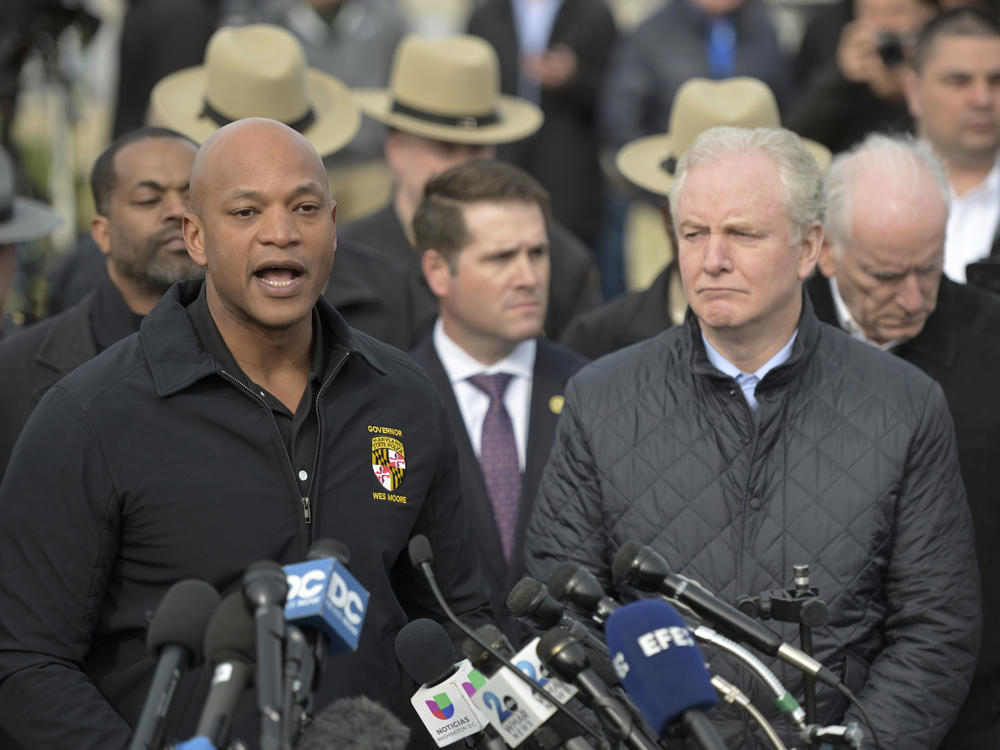Section Branding
Header Content
The Francis Scott Key bridge in Baltimore collapses after a ship crashed into it
Primary Content
Follow NPR's live blog for the latest updates and analysis.
The Francis Scott Key Bridge in Baltimore collapsed into the Patapsco River after it was struck by a nearly 1,000-foot-long container ship early Tuesday, sending several people plunging into the frigid waters below.
The collision set off a rapid search-and-rescue operation. Eight people from a construction crew that was working to repair potholes on the bridge are thought to have fallen into the water, Maryland Transportation Secretary Paul Wiedefeld told reporters.
Six people remained unaccounted for as of Tuesday afternoon, said Maryland Gov. Wes Moore in a briefing to reporters. Two people were rescued, one of whom was hospitalized.
"Response teams are doing everything in our power to rescue and recover the victims of this collapse literally as we speak," Moore said.
Authorities did not believe any drivers were submerged in their cars, Wiedefeld said.
The bridge collapsed instantly
Eyepress/Reuters
The bridge, which is part of Interstate 695, collapsed around 1:30 a.m. when it was struck by a massive cargo vessel named the Dali. Dramatic video of the collision shows the hulking ship–the length of more than three football fields– slamming into one of the bridge's pillars, and then an expanse of the bridge falling into the water instantly.
The Dali, a Singapore-flagged ship, had left Baltimore at 1 a.m. and was bound for Colombo, Sri Lanka, according to Marine Traffic, a maritime data site.
Synergy Marine Group, the company that manages the ship, said in a statement that all 22 crew members are accounted for and that there were no injuries resulting from the crash. The company also said there was no pollution to the water.
In a briefing for the media, Moore said the crew of the container ship had notified authorities about a power outage onboard shortly before the collision. The crew notified authorities of "a power issue," Moore said, confirming earlier reports that they had lost power on the ship.
The ship was traveling at approximately 8 knots when it hit the bridge, Moore said. In the immediate aftermath of the collision, officials feared motorists might be submerged in the river, but Moore said that a mayday signal was issued with enough time for authorities to stop the flow of traffic coming over the bridge.
"I have to say I'm thankful for the folks who once the warning came up, and once notification came up that there was a mayday, who literally by being able to stop cars from coming over the bridge, these people are heroes. They saved lives," Moore said.
FBI and state officials said the preliminary investigation points to an accident and that there was no credible evidence of any terrorist attack. Moore said the Francis Scott Key Bridge was fully up to code and there was no structural issue with the bridge.
"In fact, the bridge was actually fully up to code," Moore said.
The ship has had at least one previous accident
Vessel traffic in and out of the Port of Baltimore, one of the busiest on the East Coast, was suspended "until further notice," port officials announced, as search-and-rescue operations continued and the preliminary investigation into the crash was getting underway.
"This does not mean the Port of Baltimore is closed," port officials said in a statement. "Trucks are being processed within our marine terminals."
Gov. Moore declared a state of emergency and said his office was in close communication with Secretary of Transportation Pete Buttigieg. The secretary was due to arrive in Baltimore to visit the crash site and receive updates on the investigation.
The National Transportation Safety Board said it will investigate what happened, announcing on X (formerly Twitter) that it was launching a "go team" to Baltimore.
Prior to the crash, the ship had completed 27 inspections, according to a database by the maritime safety site Equasis. In one inspection at a port in Chile last year, the ship was determined to have a deficiency related to "propulsion and auxiliary machinery," according to Equasis.
In 2016, an inspection found "hull damage impairing sea worthiness" after the ship hit a dock on its way out of the port of Antwerp. Video of the incident shows the stern of the ship scraping against the quay as it attempted to exit the North Sea container terminal.
The bridge is an important travel route with deep history
The bridge's collapse leaves Baltimore and travelers along the East Coast without a vital transit corridor for the foreseeable future. The four-lane, 1.6-mile long bridge carries some 11.3 million vehicles each year, according to state data, and is one of three ways to get through Baltimore on the interstate.
Reconstructing the bridge will be a "long-term build," Moore told reporters.
Speaking from the White House, President Biden said he intends for the federal government to "pay for the entire cost of reconstructing that bridge."
"We're gonna get it up and running again as soon as possible," Biden said. "Fifteen thousand jobs depend on that port, and we're gonna do everything we can to protect those jobs and help those workers."
The bridge isn't just a vital transportation route. It also has a special historical significance.
It opened to the public in March 1977, but its history goes much deeper than that. Scholars believe it stood within 100 yards of the site where its namesake, Francis Scott Key, witnessed the failed British bombardment of Fort McHenry in September 1814.
Key, an American lawyer, watched the battle from the British warship he had boarded to negotiate the release of a detained American civilian. The awe he felt at seeing the flag rise the next morning inspired him to write "Defense of Fort McHenry," which was later renamed "The Star-Spangled Banner" and became the U.S. national anthem in 1931.
Shippers are scrambling to re-route their cargo
Roughly $80 billion worth of cargo passes through the Port of Baltimore each year. But with the port's shipping channels now closed indefinitely due to the accident, shippers have been left scrambling to find alternate routes to transport their goods to and from the East Coast.
Some vessels have already been diverted to Norfolk, Va., Margie Shapiro, who runs a freight handling business in Baltimore, told NPR. Other traffic could be re-routed through New York or Philadelphia.
The Dali was being chartered by Maersk and carrying cargo for Maersk customers, the shipping giant said in a statement. The company said it would be omitting Baltimore from its services "until it is deemed safe for passage through this area."
Cargo already at the Port of Baltimore will have to travel overland, but truck traffic will also be snarled by the loss of the bridge.
"The whole ecosystem is going to be a little bit off," Shapiro said. "When the ecosystem gets messy, things get messy. Freight rates go up. The world gets a little bit chaotic."
Correction
A previous version of this story incorrectly said the container ship is 948 feet long. In fact, it is 984 feet long.



